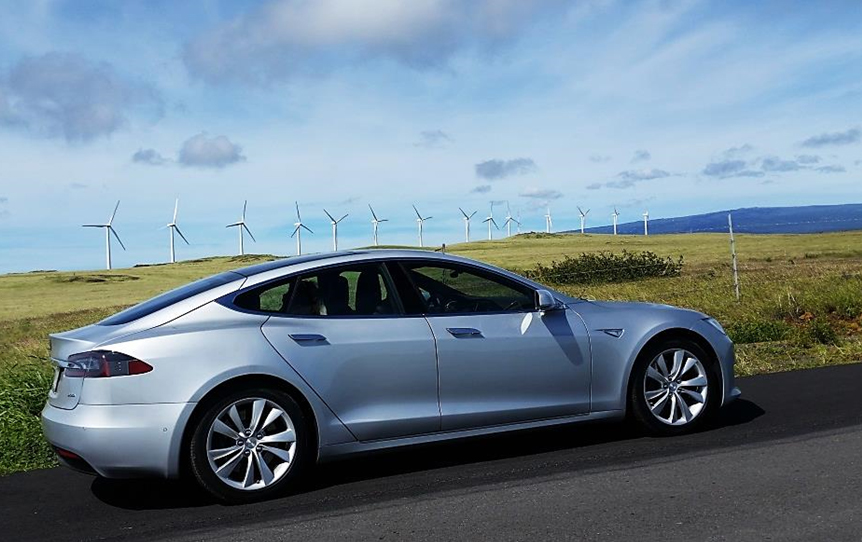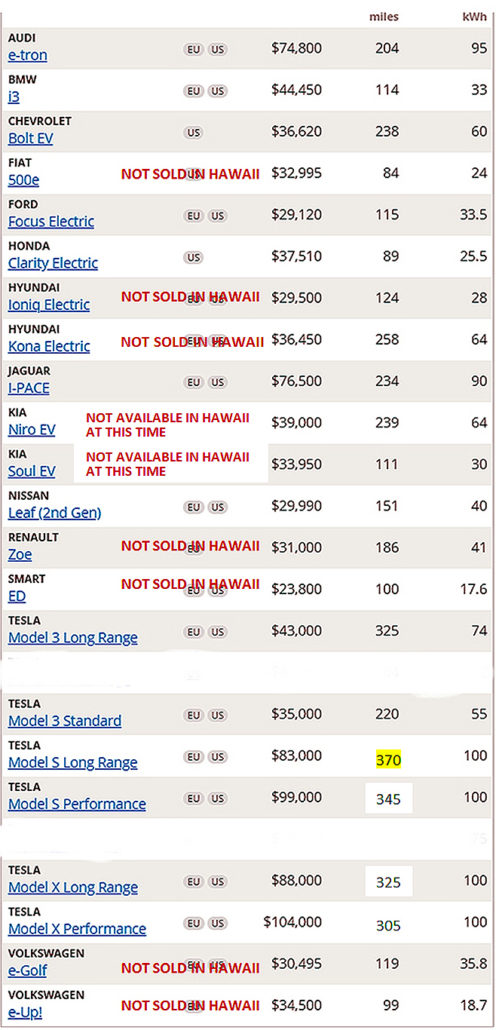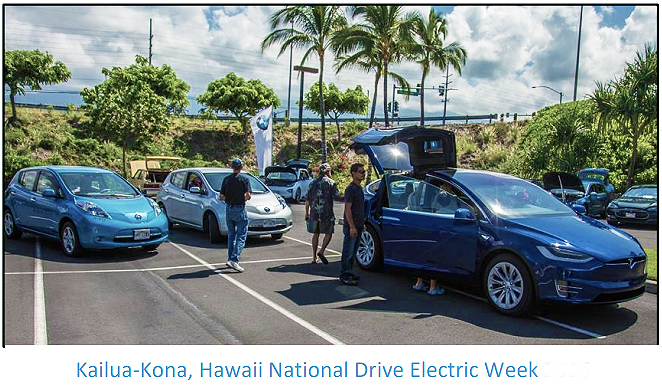EV Adoption – linchpin to Hawaii’s transportation and clean energy future
Hawai’i currently has over one million gasoline and diesel-powered vehicles on its roads, which, according to state research, emit nearly five million metric tons of climate-changing carbon pollution annually throughout the islands.
Add to that — Hawaii residents, businesses, and visitors 5 spent over $1,500,000,000 ($1.5 Billion) on imported fossil fuel purchases in 2018; dollars which otherwise could be spent to support our island economy.
Electric Vehicles (Battery Electric Vehicles aka BEV) will play a primary and enabling role in Hawaii’s journey to achieving its statewide goal of a 100% clean energy economy by 2045.
 EV’s deliver multiple benefits to the taxpayers and residents of Hawai’i. But there is a statewide disconnect between good intentions and state policies designed to support and otherwise enable the fulfillment of these benefits.
EV’s deliver multiple benefits to the taxpayers and residents of Hawai’i. But there is a statewide disconnect between good intentions and state policies designed to support and otherwise enable the fulfillment of these benefits.
First and foremost, Hawaii should be doing everything possible to create incentives, not barriers to this necessary transportation transition. The 2019 legislature’s reluctant passage of Sen. Inouye’s SB409 addition of a surcharge tax on new and annual electric vehicle registrations is an example where ill-informed lawmakers shifted EV adoption in Hawai’i into reverse.
(for 2019 legislative details read the Hawai’i Today edition of May 3rd : “Forces Inside and Outside Hawai’i Shape the State’s Climate Future”).
Second, unlike most other states, in 2019 Hawaii continues to fail to offers any economic incentives towards the advancement EV adoption in the state. State EV incentives are weak at best, and limited to select parking privileges, and for Oahu residents, access to the county’s limited HOV lanes.
State of Hawaii EV Incentives, as of 2019
- EV Lane Exemption: Qualified EVs and PHEVs may use designated HOV lanes regardless of the number of occupants in the vehicle with the correct license plate
- Parking Fee Exemption: EVs are exempt from parking fees and metered parking, but not beyond 2.5 hours or the maximum amount of time the meter allows, whichever is longest. The parking exemption only applies to daily fees, not weekly or monthly parking fees. The program sunsets on June 30, 2020.
- Parking Requirement: Public parking lots with greater than 100 spaces must offer an EV designated parking spot and offer EV charging. The State of Hawaii has a free mobile app that shows public and private charging stations.
Why Price and Choice Matter
Hawaii’s absence of state tax credits towards new and used electric vehicles purchases buyers is a policy weakness which solely relies on Federal tax credits to close the purchase price gaps between ICE and EV vehicle purchases for Hawai’i buyers seeking to go electric. New car buyers in all states, including Hawai’i, are eligible to receive a Federal tax credit up to $7,500. This incentive, however, is short lived for the most successful car companies, e.g., Tesla and GM whose EV’s model sales exceeded the Federal limit of 200,000 electric vehicle sales and no longer qualify for the Federal tax credit assistance program set aside for EV purchases. Hawaii residents interested in a new and affordable Tesla Model 3 or Chevy Bolt are just out of luck.
Nationally, EV sales presently represent only 2.4 percent of all passenger car and truck sales in the U.S. As of January 2018, the number of electric vehicles registered in Hawai’i reached 6,748 – that number stands in contrast to over one million polluting ICE vehicles also registered in the state. In effect, the electric vehicle population in Hawai’i is far outnumbered by their gasoline-diesel powered counterparts.
In contrast to this proportional reality, lawmakers tout Hawai’i as having the second-highest rate of EV adoption in the country. That statement may be correct, but when Hawaii’s EV population starts near zero, the adoption rate even in small numbers looks grand. But that’s beginning to slowly change as EV choices, price ranges, and model options continue to expand with each new model year. 
Cost matters to consumers across the price range for big ticket purchases likes cars and houses. But some of Hawaii’s legislators, including Senator Inouye, believe falsely that only wealthy people can afford electric vehicles, that’s assumption belies the facts.
This graph shows 2019 EV models presently available for sale in Hawai’i, their estimated purchase price before Federal tax incentives, their estimated driving range between charges, and their respective battery (engine) size.
In fact, EV’s like their ICE (Internal Combustion engine) counterparts come in a wide range of prices, with several EV manufacturer models are now comparably priced to similar Honda, Toyota, or Hyundai ICE vehicles. However, ICE vehicles mostly maintain a purchase price advantage over similar EV models, ranging several thousand dollars or more. On average, last year (2018) EVs had an initial purchase price which was generally 15-20% higher than comparable gasoline powered vehicles.
We are now seeing EV battery cost reductions being passed on to consumers. Combined with vehicle design efficiency improvements and technology advances, electric vehicle prices are beginning to drop and consumers are getting greater value for purchase dollars. This was recently demonstrated by the EV market leader Tesla, which lowered 2019 vehicle prices and added driving range to its 2019 premium models, the S and X.
Fuel and Other Ownership Costs Considerations
There are many different ways to view vehicle ownership costs, but the two primary considerations are vehicle purchase costs and the lifetime cost of ownership – maintenance.
Electric Vehicles (EV) offer some distinct cost advantages over internal-combustion engine (ICE) vehicles, primarily in reduced maintenance costs and not having to buy gas …ever —which can make electric vehicles significantly cheaper than the comparable internal-combustion engine vehicles during their ownership lifespan. This is especially true when trading gallons of gas purchased for plugging in by Hawaii’s residents who choose to power not only their homes, but their vehicles from the sun. The expansion of this zero emissions opportunity is easily expandable to Hawaii’s residents living in condos and apartments without garage parking and charging through a variety options in the state’s policy transition to clean energy.
Today’s so-called efficient cars and trucks still burn lots of fuel fossil getting from point A to point B. To repeat: Hawaii residents, businesses, and visitors 5 spent over $1,500,000,000 ($1.5 Billion) on imported fossil fuel purchases in 2018.
Beyond fuel costs at the gas pump which require many costly and time wasting trips to local gas stations to re-fuel over and over and over again, there are larger considerations facing the state, and the planet as a whole. Fossil-fueled transportation pollutes our island skies, advances global warming impacts (something we should be acutely aware of living on an island facing rising sea levels and extreme storm events).
But less obvious cost for ICE owners are the engine and drivetrain maintenance costs. Paid over the vehicle life, drivers of traditional, non-electric vehicles face a huge operating money sink, especially as ICE vehicles age. Changing engine oil, coolant, transmission fluid, and belts all add up maintenance ownership costs over time.
By comparison, electric cars don’t have internal combustion engines, so these costs disappear. Universal vehicle expenses like tire and brake changes, insurance, and structural repair are part of owning any vehicle, but EV owners avoid many of the repeated costs associated with combustion engine upkeep.
A 2018 study from the University of Michigan’s Transportation Research Institute found that electric vehicles cost less than half as much to operate as gas-powered cars. The average cost to operate an EV in the United States is $485 per year, while the average for a gasoline-powered vehicle is $1,117.
But what are the true EV cost benefits for society and Hawai’i as a whole?
First and foremost, Hawaii’s fossil-fueled transportation options carry with them not only passengers, but externality costs for Hawaii’s taxpayers, primarily in the form of economic and environmental costs by worsening the growing impacts of climate change on Hawaii and its island economy.
By not advancing the public and private sector adoption of electric vehicles, state and county officials are operating in a mode that runs completely counter to Hawaii’s 2045 100% renewable energy and sustainability goals, which seek end the state’s addiction to imported fossil fuels.
EV adoption and market share growth of the now dominant ICE vehicle marketplace will take several converging factors:
- Private and public sector interest groups must come together on common implementations goals and strategy for the state.
- A statewide EV charging infrastructure must be established, not just on Oahu
- EV purchase costs must be competitive at the sticker cost level with comparable ICE options, meaningful state tax incentives will go a long way towards fulfilling this goal, and can be phased out over time once critical mass adoption has been achieved
- Changes to Hawaii’s current energy policy and regulations that discourage and create barriers to rooftop solar + EV adoption must be addressed holistically, not piecemeal.
Seeing is Believing – Ford introduces its new all electric F-150 pick-up truck …
While Ford is yet to announce a concrete release date for its all-electric F-150, today, the company debut to the world it’s F-150 EV pick-up truck. The popular pick-up with an EV drivetrain is designed to ensure that the company’s upcoming pivot to electric vehicles will be a success. The Detroit-based carmaker showcased how much cargo its upcoming battery powered electric truck could actually tow. As it turns out, the figure lies somewhere between zero and 1.25 million pounds.
Ford also recently announced its partnership with Volkswagen, which will allow Ford to use the German carmaker’s battery architecture. Ford has also invested $500 million in electric truck startup Rivian, which will give the veteran automaker access to the startup’s skateboard platform. Ford plans includes the production of over a dozen electric and electrified models by 2022.
Look to the future – which has already arrived
The United Kingdom’s National Grid is presently working on a national clean energy strategy whereby electric vehicles will, in effect, be rolling battery storage modules for the grid. The idea is not new, but implementation at the national grid level is unprecedented.
HECO also speaks of a future for Hawaii’s island-individual energy grid systems in which EV’s play a primary role by enabling grid-level power management of wind and solar power production, in effect, providing greater flexible in managing power fluctuations between supply and demand. But unlike the UK plan, HECO’s green energy plans does not mention the economic benefits and advantages of switching off of expensive fossil fuels and bringing down energy costs for consumers and EV owners.
As a national plan, the UK vision is bold and will require the support of policymakers. The UK energy sector also predicts electric vehicles will become the most popular form of transport between 2030 and the early 2040s. It also predicts that many more homes and communities will generate their own electricity through solar panels or micro wind power projects.
None of this seems especially remarkable, in fact, of course the UK considers and plans for EV’s having a pivotal role in their clean energy-storage-management transition plans.
Nearer to home, island life goes on. Our county governments, communities, developers, along with present and future EV owners struggle with the basic question of where do I charge my EV? The stakeholders look to Oahu or Washington D.C. for guidance and resources, but find little to none, just missed opportunities as the legislative clock ticks down to 2045 – well there’s always next year…




Leave a Reply
Join the Community discussion now - your email address will not be published, remains secure and confidential. Mahalo.